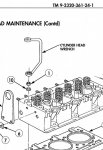pitpawten
Active member
- 259
- 199
- 43
- Location
- Centreville, Maryland
Pulled the front plug, nothing but black oil, then pulled the back drain plug that drains the little bump-out area on the rear part of the oil pan.
What appeared to be water, maybe 1/2 gallon came out FIRST and then nice black oil. Did not appear to be coolant from the smell, though there is a slight yellowish tint.
Truck has sat 3 years but did not have any running issues when parked. Any chance of:
1. Coolant leaking in while sitting somehow?
2. Exhaust stack filling and draining back through turbo into exhaust manifold and down into cylinders? (the bucket I had on top of the stack died after a year or so)?
What appeared to be water, maybe 1/2 gallon came out FIRST and then nice black oil. Did not appear to be coolant from the smell, though there is a slight yellowish tint.
Truck has sat 3 years but did not have any running issues when parked. Any chance of:
1. Coolant leaking in while sitting somehow?
2. Exhaust stack filling and draining back through turbo into exhaust manifold and down into cylinders? (the bucket I had on top of the stack died after a year or so)?













